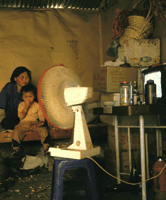This week in the BMJ
Volume 329,
Number 7464,
Issue of 28 Aug 2004
![[Down]](/icons/down.gif) Environmental factors linked to asthma prevalence disparity
Environmental factors linked to asthma prevalence disparity
![[Down]](/icons/down.gif) Corticosteroids reduce mortality in intensive care
Corticosteroids reduce mortality in intensive care
![[Down]](/icons/down.gif) Asthma prevalence has not increased in Aberdeen
Asthma prevalence has not increased in Aberdeen
![[Down]](/icons/down.gif) Breast screening works less well in some groups of women
Breast screening works less well in some groups of women
![[Down]](/icons/down.gif) Enteral feeding practices can be improved
Enteral feeding practices can be improved
Environmental factors linked to asthma prevalence disparity
Lifestyle and dietary factors may explain variations in the prevalence of asthma. Surveying over 10 000 Chinese children in Hong Kong, Beijing, and Guangzhou, Wong and colleagues (p 486) found that those living in Hong Kong were more likely to have asthma than those living in other regions (odds ratio 1.64; 95% confidence interval 1.35 to 1.99). Use of gas for cooking, foam pillows, and house dampness increased the likelihood of asthma, but eating fruits and raw vegetables and using cotton bedding protected against it.

| |
Credit: MARK HENLEY/PANOS
|
|
![[To top]](/icons/back.gif)
Corticosteroids reduce mortality in intensive care
Long courses of corticosteroids may reduce mortality in patients who have severe sepsis and septic shock. Reviewing 16 trials on 2063 patients, Annane and colleagues (p 480) found that corticosteroid did not change mortality at 28 days or hospital mortality. However, those patients who had low dose hydrocortisone ( 300 mg) for at least five days were more likely to survive, without increased risk of gastroduodenal bleeding, superinfection, or hyperglycaemia, than those receiving a short course of corticosteroids or placebo. This treatment may be more effective in patients with impaired production of corticosteroids, say the authors.
300 mg) for at least five days were more likely to survive, without increased risk of gastroduodenal bleeding, superinfection, or hyperglycaemia, than those receiving a short course of corticosteroids or placebo. This treatment may be more effective in patients with impaired production of corticosteroids, say the authors.

| |
Credit: JOISIN/PHANIE/REX
|
|
![[To top]](/icons/back.gif)
Asthma prevalence has not increased in Aberdeen
The prevalence of symptoms suggestive of childhood asthma remained stable in the Scottish city of Aberdeen between 1994 and 1999. Devenny and colleagues (p 489) studied 3537 children from the same primary schools that had been surveyed in 1964, 1989, and 1994 and found that a quarter of the children had been diagnosed as having asthma at some time in their lives, but the prevalence of asthma or wheeze changed little over time. Eczema and hay fever were more likely in 1999 than in 1994.

| |
Credit: P TOMKINS/SCOTTISH VIEWPOINT
|
|
![[To top]](/icons/back.gif)
Breast screening works less well in some groups of women
Mammographic screening is less likely to be sensitive and specific in women who have had breast surgery, thin women, and women taking hormone replacement therapy. At one year follow up after screening of 122 355 women aged 50-64, Banks and colleagues (p 477) confirmed that screening was less accurate in women taking hormone replacement therapy and found a similar effect in women with a low body mass index and those who had had a breast operation for conditions other than cancer. These conditions are all associated with denser breast tissue.
![[To top]](/icons/back.gif)
Enteral feeding practices can be improved
Interdisciplinary teamwork and focused educational effort can improve enteral nutrition practice in patients with dementia. Monteleoni and Clark (p 491) report on a quality improvement intervention in a large acute care hospital in New York City, where medical and allied health staff received educational programmes on end of life care, and on feeding management. After these interventions, the number of feeding tubes placed was greatly reduced. The authors emphasise the importance of an established unified goal of care for each patient.

| |
Credit: JAN BANNING/PANOS
|
|
![[To top]](/icons/back.gif)
Environmental factors linked to asthma prevalence disparity
Corticosteroids reduce mortality in intensive care
Asthma prevalence has not increased in Aberdeen
Breast screening works less well in some groups of women
Enteral feeding practices can be improved
 300 mg) for at least five days were more likely to survive, without increased risk of gastroduodenal bleeding, superinfection, or hyperglycaemia, than those receiving a short course of corticosteroids or placebo. This treatment may be more effective in patients with impaired production of corticosteroids, say the authors.
300 mg) for at least five days were more likely to survive, without increased risk of gastroduodenal bleeding, superinfection, or hyperglycaemia, than those receiving a short course of corticosteroids or placebo. This treatment may be more effective in patients with impaired production of corticosteroids, say the authors. 


